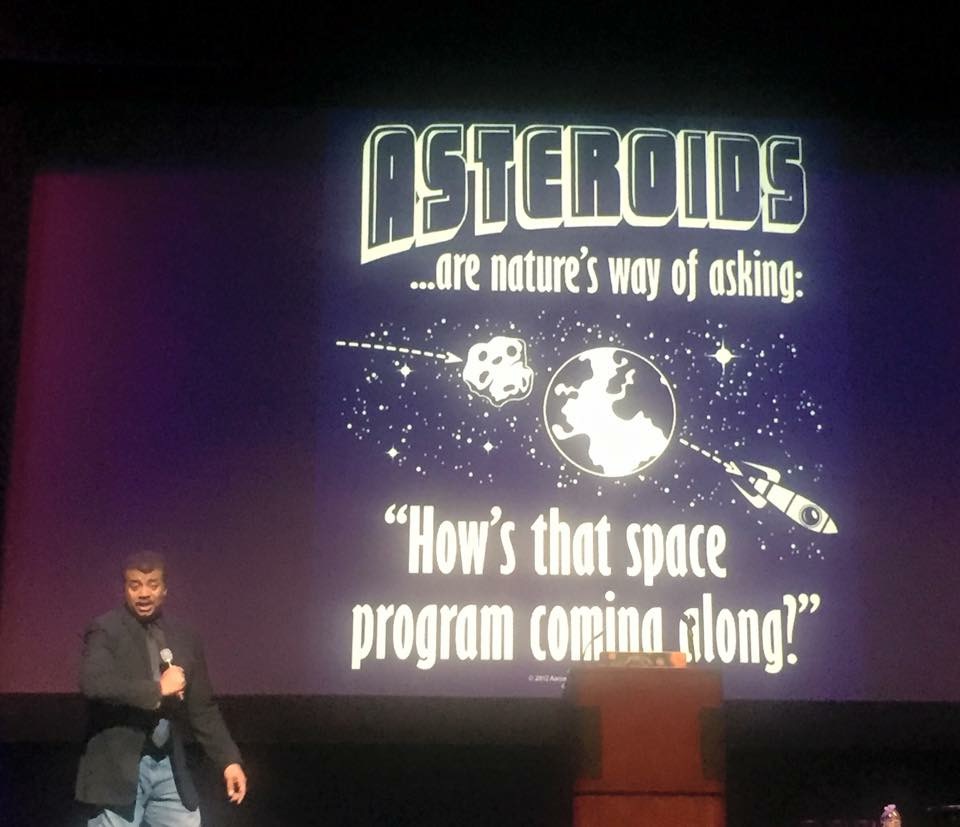

Asteroid Defense
Preventing Comet and Asteroid Impacts
The Threat of Rogue Comets and Asteroids
Introduction, Web Links, Film Reviews, & Bibliography
Compiled by John D. Furber
Updated 6 January 2024
[ John D. Furber home page ]

The following is general background information on the
ASTEROID and COMET Impact Threat
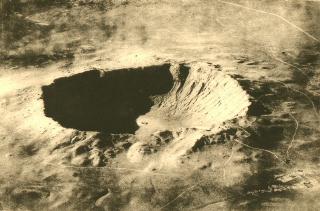 I have become very interested in asteroid and comet impacts because they can threaten the survival of our society and our species. In our Solar System, each of the planets is hit by large, high-velocity rocks at unpredictable times. A striking example occured in July 1994 when we observed Jupiter being struck by a series of large comet fragments.
I have become very interested in asteroid and comet impacts because they can threaten the survival of our society and our species. In our Solar System, each of the planets is hit by large, high-velocity rocks at unpredictable times. A striking example occured in July 1994 when we observed Jupiter being struck by a series of large comet fragments.
The chances of a comet or large asteroid heading for Earth are high...
(based upon extrapolations from astronomical observations and past impacts).
We just don't know when...
It could be 6 months or 6,000 years,
so we need to invest in a preparedness plan to locate and divert the big rock
to harmlessly miss us.
This would be common-sense disaster insurance to protect civilization. [John D. Furber, 2017]
The photo at right is the Arizona Meteor Crater, located in the Arizona desert of the United States. It is more than a mile across. Between 20,000 and 50,000 years ago, a small metallic asteroid, about 25 meters (80 feet) in diameter impacted the Earth and formed this crater. (Smithsonian Scientific Series (1929), taken by the U.S. Army Air Service. Public domain.)
- A meteorite which is 50 meters (150 feet) or more in diameter can wipe out a whole city. A larger meteorite hitting the ocean would cause tsunamis, huge waves which could wipe out all of the coastal cities on the shores of that ocean.
- A meteorite several kilometers in diameter (more than a mile) would cause global firestorms, trigger massive earthquakes, volcanic eruptions, and tsunamis, and terminate human civilization and most "higher" species of life on Earth. For example, a 10 km (6 mile diameter) meteorite struck the Yucatan region of Mexico 65 million years ago, wiping out many species including the dinosaurs, who had successfully lived on the Earth far longer than have the humans. The Chicxulub crater which resulted is more than 180 km (100 miles) in diameter.
- On June 30, 1908, a 60-meter (200 foot) meteor exploded in the atmosphere above Siberia near Tunguska, knocking down trees for hundreds of square kilometers.
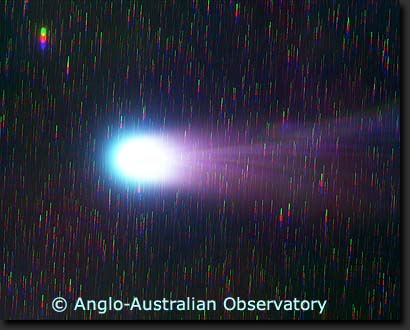 Comet Hyakutake, pictured at right, was photographed by the Anglo-Australian Observatory as the comet raced by the Earth in March 1996. It was discovered only 7 weeks earlier! If it had been headed for a collision with Earth, 7 weeks would not have given us time to prepare and implement a successful diversion program.
Comet Hyakutake, pictured at right, was photographed by the Anglo-Australian Observatory as the comet raced by the Earth in March 1996. It was discovered only 7 weeks earlier! If it had been headed for a collision with Earth, 7 weeks would not have given us time to prepare and implement a successful diversion program. On the other hand, if a comprehensive sky survey were in progress, Comet Hyakutake could have been discovered months or years earlier. And if diversion planning is begun in advance, then the longer lead time could be used to send up a rocket to divert an incoming comet before it strikes the Earth. The expense of such preparations could be justified as buying DISASTER INSURANCE or implementing safety programs.
Calvin Hamilton of the Los Alamos National Laboratory points out that "Earth's atmosphere protects us from the multitude of small debris, the size of grains of sand or pebbles, thousands of which pelt our planet every day. The meteors in our night sky are visible evidence of bodies of this type burning up high in the atmosphere. In fact, up to a diameter of about 10 meters (33 feet), most stony meteoroids are destroyed in the atmosphere in a terminal explosion. Obviously, some fragments do reach the ground, because we have stony meteorites in our museums. Such falls are known to cause property damage from time to time. On October 9, 1992, a fireball was seen streaking across the sky all the way from Kentucky to New York. A 12-kilogram (27-pound) stony meteorite (chondrite) from the fireball fell in Peekskill, New York, punching a hole in the rear end of an automobile parked in a driveway and coming to rest in a shallow depression beneath it. Falls into a Connecticut dining room and an Alabama bedroom are other well documented incursions in this century. A 10-meter (33-foot) body typically has the kinetic energy of about five Hiroshima fission bombs, however, and the shock wave it creates can do considerable damage even if nothing but comparatively small fragments survive to reach the ground.
"Many fragments of a 10-meter (33-foot) iron meteoroid will reach the ground. The only well studied example of such a fall in recent times took place in the Sikhote-Alin Mountains of eastern Siberia on February 12, 1947. About 136 metric tons (150 tons) of fragments reached the ground, the largest intact fragment weighing 1,741 kilograms (3,839 pounds). The fragments covered an area of about 1 to 2 square kilometers (0.4 to .8 square miles), within which there were 102 craters greater than 1 meter (39 inches) in diameter, the largest of them 26.5 meters (87 feet), and about 100 more smaller craters. If this small iron meteorite had landed in a city, it obviously would have created quite a stir. The effect of the larger pieces would be comparable to having a supersonic auto suddenly drop in! Such an event occurs about once per decade somewhere on Earth, but most of them are never recorded, occurring at sea or in some remote region such as Antarctica." (Calvin J. Hamilton, Los Alamos National Laboratory)
On 15 February 2013, the Chelyabinsk meteor entered Earth's atmosphere over the southern Ural region in Russia. It was an approximately 18 m (59 ft) diameter, 10,000ton near-Earth asteroid that entered the atmosphere with a speed relative to Earth of 19 kilometres per second ( 43,000 mph). The light from the meteor was briefly brighter than the Sun, visible as far as 100 km (60 mi) away. It was observed in a wide area of the region and in neighboring republics. Some eyewitnesses also reported feeling intense heat from the fireball.
See Wikipedia https://en.wikipedia.org/wiki/Chelyabinsk_meteor
The PBS science documentary NOVA covered this in detail. https://www.pbs.org/wgbh/nova/video/meteor-strike/
The importance of these rather small meteorites is that they remind us of the fact that rocks are bombarding us unannounced, and that one as large as the one that wiped out the dinosaurs could be on its way without our knowledge.
Taking Protective Action
Not only are these facts of fascinating scientific and historical interest, but we are able to take political and technological actions now to DETECT and DEFLECT the next one before it hits us. We can encourage our governments and universities to install the 25 automated, widefield CCD telescopes necessary for the early detection system.
Fear can be an appropriate first reaction, for it can spur people to examine the problem more closely and to take positive, constructive actions. As a society which hopes to endure, two kinds of action are necessary, and fortunately, they are possible with current technology.- We need to scan the entire sky every month to identify and catalog asteroids and comets which cross the orbit of the Earth. With computers, we can plot their future paths (orbits) to identify which ones are on a path to hit the Earth. This requires a modest program of about 25 automated widefield, 1-meter diameter telescopes with CCD detectors and computerized image analyzers, like the one borrowed from the US Air Force on Maui. And of course we need the astronomers to operate them. This would cost maybe $20 million per year, which is a small fraction of the NASA or NSF budget. By identifying the object months or years in advance, it is much easier to take effective action to either divert its path or break it into small enough pieces to safely burn up in the Earth's atmosphere.
- Preparations need to be made to respond to an incoming asteroid or comet when it is identified by the astronomers. Some of the scientists and engineers who developed nuclear weapons and missiles are becoming interested in adapting these missiles and bombs to this healthy activity. With enough lead time, even a very small change in momentum will be enough to deflect its path and cause it to miss the Earth. Preliminary studies have been conducted by scientists from:
- US Air Force
- Los Alamos National Laboratory
- Lawrence Livermore National Lab
- US Department of Energy
- US Naval Research Lab
- American Institute of Aeronautics and Astronautics
- Russian Federal Nuclear Center
- China (Beijing) Center of Advanced Science and Technology.
- The Asteroid Impact & Deflection Assessment (AIDA) mission is a joint international collaboration of the European Space Agency (ESA), the German Aerospace Center (DLR), Observatoire de la C™te d«Azur (OCA), NASA, and John Hopkins University Applied Physics Laboratory (JHU/APL). The primary goals of AIDA are to test our ability to perform a spacecraft impact on a potentially hazardous near-Earth asteroid and to measure and characterize the deflection caused by the impact. https://www.esa.int/Our_Activities/Space_Engineering_Technology/NEO/Asteroid_Impact_Deflection_Assessment_AIDA_study
Deflection proposals have so far included:
- Attaching large solar sails to divert the object with the force of the solar wind.
- Installing mass drivers powered by photovoltaics or nuclear power. The momentum of ejecting pieces of the object would change its course in the opposite direction.
- Sending a Pusher Tug spacecraft to push the object, changing its orbit enough to miss the Earth.
- Sending an Impactor Spacecraft to ram the object, changing its orbit enough to miss the Earth.
- Detonating nuclear explosives above the surface of the object to change its course.
- Drilling and planting nuclear explosives inside the object to break it up and change its course. (See David Dearborn links, above.)
- Laser Deflection might potentially respond much quicker. There are two suggested methods.
- The first method would fire powerful laser pulses at the object from very large lasers that have been prepositioned in space, or on a moon base. This would vaporize spots of ice or frozen methane on the asteroid surface. This vapor and debris would act like a rocket thruster, pushing the asteroid in the opposite direction and change its course. Provided that the moon-based or space-based laser is built ahead of time, the laser beam could begin deflecting the object within minutes. This technique avoids the long delivery time of sending a spacecraft out to the location of the object (which could take months to reach the object). Calculations and design choices need to be made so that over very long distances, the laser beam would not disperse too much to provide effective heating.
- The second method would transport a powerful laser on a rocket to orbit the object, and fire laser pulses from close range. However, this would take weeks or months to reach the asteroid, so it would not provide the rapid response of a long-distance laser beam. But, this method does have an advantage over sending up a pusher rocket, in that large amounts of fuel and reactions mass need not be transported to the object. DANIEL D. MAZANEK at the NASA Langley Research Center in 2005 described the Comet/Asteroid Protection System (CAPS).
Here is a 10 page summary:
https://https://ntrs.nasa.gov/archive/nasa/casi.ntrs.nasa.gov/20050186565.pdf
- Laser Deflection: Richard Fork, at the University of Alabama, described a variation of the Laser Defection concept in 2012:
https://www.gizmag.com/cost-effective-laser-based-asteroid-defence-system/29199/
- Laser Deflection: Professors Philip M. Lubin and Gary B. Hughes described a variation of the Laser Defection concept in 2013.
- Solar Mirrors: The Planetary Society described a concept to send spacecraft with mirrors to focus the sun's energy onto the surface of the comet.
https://www.planetary.org/explore/projects/laser-bees/
However, because narrow beams of sunlight cannot be sent long distances, this would require weeks or months to send the spacecraft out to the vicinity of the comet or asteroid. Thus, it would not provide the instantaneous response of a long-distance laser beam.
But, this method does have an advantage over sending up a pusher rocket, in that large amounts of fuel and reactions mass need not be transported to the object. Furthermore, an energy source for a powerful laser need not be transported.
- The "Gravity Tractor", in spite of its clever name, is technically inferior to the other proposals for the following reasons:
1) It requires that a very large mass be delivered to the vicinity of the asteroid and then be slowed to match the speed of the asteroid. This heavy mass would require a lot of fuel to accelerate, and then more fuel to decelerate the mass. Even more fuel would be required if the mass must be launched up from Earth. On the other hand, if the mass is not brought up from Earth, then it would need to mined from the moon or another asteroid or comet. That would cost precious time if it is not done in advance. And there would still be the large amount of fuel needed to accelerate and decelerate the mass to deliver it to the asteroid in a reasonable time.
2) After the large mass has been brought into position to hover next to the asteroid, fuel must be burned to hover, BUT the thrusters MUST NOT point in the direction of the asteroid, or else the particles of the exhaust would be pushing the asteroid in the direction opposite to the direction that the gravity tractor is trying to pull it. The gravity traction would be cancelled out by the rocket exhaust momentum, and the asteroid would not be deflected at all. Therefore, in order to avoid cancellation, the thrusters must point at an angle to miss the asteroid. This reduces the effective thrust vector by cosine theta, and increases the fuel requirement by 1/(cos theta). If the spacecraft is positioned further from the asteroid to narrow the theta angle, then the gravitational force to move the asteroid is reduced by 1/(r squared).
In conclusion, for a given maximum payload delivered to the asteroid, the "Gravity Tractor" does less to divert the asteroid than other plans, such as a pusher tug, an impactor, or a standoff nuclear blast.
An inspiring TED Talk is given by Phil Plait. https://www.ted.com/talks/phil_plait_how_to_defend_earth_from_asteroids
He introduces some of the main points, although he misses the problems with the "Gravity Tractor", which I have discussed above.
Additional background information is being compiled on the Wikipedia page:
https://en.wikipedia.org/wiki/Asteroid_impact_avoidance
As individual citizens, we can encourage our government to increase current efforts to scan the skies. Interestingly, in the summer of 1994, the US House of Representatives asked NASA to take these actions, and several months later, NASA refused. We need to remind our government employees how important this is to all of us.
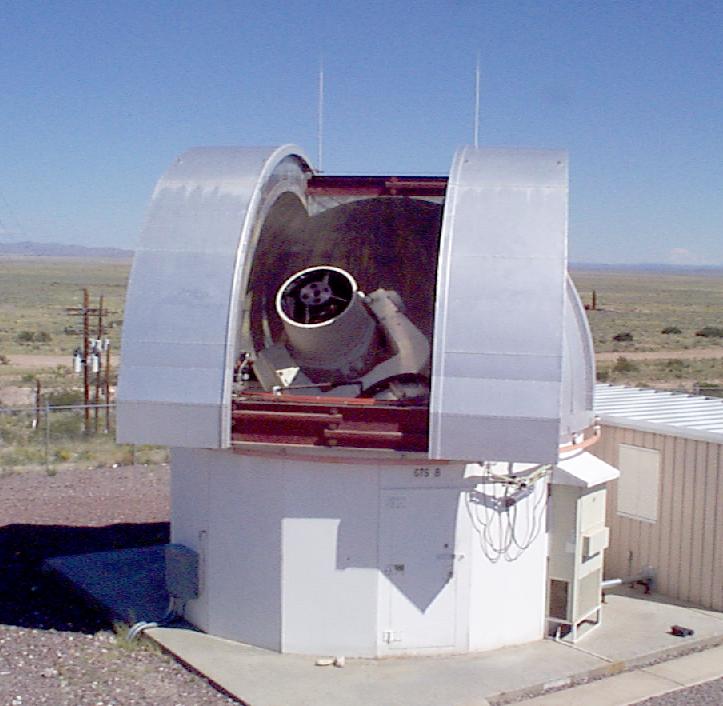
Private Sponsorship:
If the United States Government remains unresponsive, the telescopes are not too expensive to be built and operated by individual universities, corporations, or private foundations. Their observations could be coordinated via the Smithsonian Institution. The Maui telescope is one of a set of 6 or more that were built for the US Air Force to track satellites and missiles. They have been lending it to the asteroid search for two weeks out of every month. Another, pictured at left, is operated in New Mexico by The LINEAR Project of the MIT Lincoln Laboratory. We could go to the manufacturers, who built them for the Air Force and Lincoln Laboratories, so that we could find out about making more. They cost about $100,000 each. A complete program will need 25 telescopes and would cost about $30 million, including salaries and buildings. This is a small budget, by government standards, and highly worthwhile insurance for human society.Furthermore, we could be do this one-telescope-at-a-time, at different universities or observatories, in different countries, or with funding from different corporate or foundation sponsors.
A more thorough search is planned by the B612 Foundation, https://b612foundation.org/, which is soliciting donations to enable their plans to launch satellite-based tracking systems. The B612 Foundation has set up the Asteroid Institute at the University of Washington to study techniques for detecting and diverting near-Earth objects that may threaten our planet.
See this news story (13 June 2017) www.geekwire.com/2017/asteroid-institute-b612-uw/
One B612 project is https://sentinelmission.org/, to launch a space telescope, which would orbit the Sun inside the Earth's orbit. This space telescope would look outward, using reflected sunlight to find and track many more asteroids and comets than have been cataloged from Earth-based telescopes to date. Here is a news story about the project (27 April 2015) https://spacenews.com/space-telescope-concepts-seek-to-detect-smaller-near-earth-asteroids/
Long lead times are essential
to successfully divert these objects
to safely miss us.
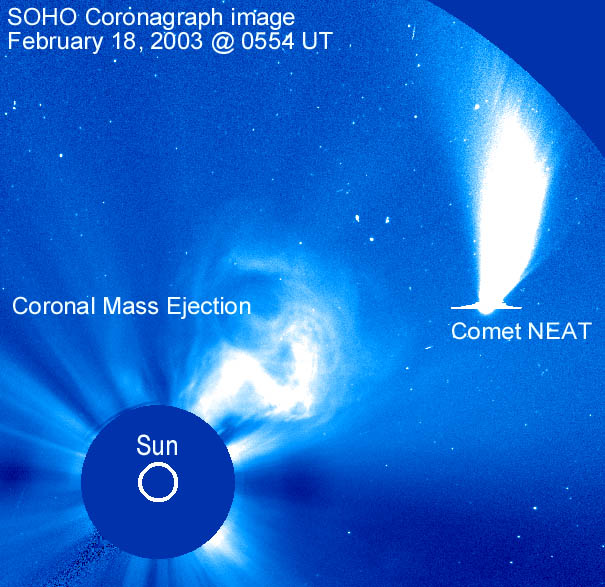
PARABOLIC COMETS (Long-period comets)
are a special threat because:
- They come through the Solar System only in once in human history, so we have no historical records by which to predict them.
- They can come in from any direction, including the north or south pole, unlike most asteroids which come from the narrow plane of the ecliptic.
- They come at extremely high velocities (50,000 miles per hour).
- They can be very large.
- They could smash the Earth on their FIRST PASS through the inner Solar System.
Hence the NEED TO SCAN THE ENTIRE SKY EVERY MONTH.
(Photo at right) The ESA/NASA SOHO orbiting solar observatory shows the huge, long-period "Comet NEAT", not visible from Earth, as is approaches from behind the sun. https://sohowww.nascom.nasa.gov/hotshots/2003_02_12/So, if you have any personal contacts in Government, corporations, academia, or a philanthropic foundation, we need you to talk to them about establishing more telescopes to open our eyes to the rocks and mountains whizzing by us in the Solar System.
Related Web sites:
- International Asteroid Warning Network is at https://iawn.net/
IAWN was established (2013) as a result of the UN-endorsed recommendations for an international response to a potential NEO impact threat, to create an international group of organizations involved in detecting, tracking, and characterizing NEOs. The IAWN is tasked with developing a strategy using well-defined communication plans and protocols to assist Governments in the analysis of asteroid impact consequences and in the planning of mitigation responses.
Currently, IAWN includes members from Europe, Asia, South and North America.
- The Jet Propulsion Laboratory (NASA and CalTech) has more information about asteroids and near-Earth objects at:
- NASA's Planetary Defense Coordination Office is at https://www.nasa.gov/planetarydefense/
- NASA's Asteroids, Comets & Meteors web site is at https://science.nasa.gov/asteroids-comets-meteors/
- Vox.com , NASA has found 16,000 asteroids near Earth. Don't panic. By Brian Resnick and Kavya Sukumar. July 20, 2017
- Asteroid Watch update, 26 March 2015, JPL, CalTech, and NASA. Millions of images of celestial objects, including asteroids, observed by NASA's Near-Earth Object Wide-field Infrared Survey Explorer (NEOWISE) spacecraft now are available online to the public. NEOWISE is a space telescope that scans the skies for asteroids and comets. The telescope sees infrared light, which allows it to pick up the heat signature of asteroids and obtain better estimates of their true sizes. As a result, NEOWISE can see dark asteroids that are harder for visible-light surveys to find. Nearly all of the NEOWISE discoveries have been large -- hundreds of meters wide -- and very dark, as black as soot or printer toner. NASA also announced that it increased the detection of near-Earth Asteroids by 65 percent in the three years following the start of its asteroid initiative in 2012.
- For more information about NEOWISE, visit:
https://www.nasa.gov/neowise
- To view the NEOWISE data, visit:
https://wise2.ipac.caltech.edu/docs/release/neowise/
- The Asteroid and Comet Impact Hazards web site was maintained by David Morrison at the NASA Ames Research Center. Now offline. Perhaps you can find it on the Internet Archive Wayback Machine.
- The Near Earth Asteroid Rendezvous - NEAR site at Johns Hopkins Applied Physics Lab has news, mission history, spacecraft description, images, and movies of EROS from the NEAR spacecraft.
- The NASA NEO Program also maintains an updated list of currently known Potentially Hazardous Asteroids.
- The NEODyS Near Earth Object Dynamic Site provides information on all Near Earth Asteroids. Each NEA has its own dynamically generated home page providing information and services. The site is maintained by an Italian group started by Andrea Milani.
- The NASA/JPL Comet Observation Home Page maintained by Charles S. Morris.
- The LINEAR Project of the MIT Lincoln Laboratory is funded by the US Air Force. The goal of the LINEAR project is to demonstrate the application of technology originally developed for the surveillance of earth orbiting satellites, to the problem of detecting and cataloging Near Earth Asteroids (also referred to as Near Earth Objects, or NEOs) that threaten the Earth.
- The Spacewatch Project of the University of Arizona Lunar and Planetary Observatory.
- The JPL Picture Archive has radar images of asteroid Kleopatra.
- Views of the Solar System
- The Planetary Defense Workshop, May 22-26, 1995,
Lawrence Livermore National Laboratory at Livermore, California. There have been subsequent workshops and conferences in recent years. Try searching for them.
- US Space Command -- Their primary mission is to watch for missiles, but they also monitor space junk in Earth orbit.
- The Minor Planet Center operates at the Smithsonian Astrophysical Observatory under the auspices of the International Astronomical Union. It is responsible for the efficient collection, computation, checking, and dissemination of astrometric observations and orbits for minor planets and comets.
- The Dragonstorm Project is a visually interesting website produced by amateur geologist Dennis Cox, to provide evidence supporting the hypothesis that a swarm of comet fragments exploded in the air, creating a firestorm that caused a mega-faunal extinction 12,900 years ago. https://sites.google.com/site/dragonstormproject/Home Complementary evidence is provided on the PBS NOVA website for the episode "Megabeasts' Sudden Death". https://www.pbs.org/wgbh/nova/clovis/
- James A. Marusek has printed instructions for building and operating an impact shelter at https://personals.galaxyinternet.net/tunga/
- SpaceWeather.com has Science news and information about the Sun-Earth environment including Near Earth Objects.
- Links to other Astronomy and Physics sites, compiled by John D. Furber.
MAGAZINE Articles:
- "Asteroid Bennu Has a Chance for Gigaton Impact Around 2175-2199" by Brian Wang,
Next Big Future, February 13, 2020.
- "Billion-Ton Comet May Have Missed Earth by a Few Hundred Kilometers in 1883," (The Physics arXiv Blog, October 17, 2011) Technology Review.
https://www.technologyreview.com/view/425780/billion-ton-comet-may-have-missed-earth-by-a-few-hundred-kilometers-in-1883/ - Dana Desonie. "The Threat from Space," (cover story) Earth. August 1996 pp. 24-31.
- Tom Gehrels. "Collisions with Comets and Asteroids," Scientific American. March 1996. pp. 54-59.
- David Morrison. "Target: Earth," (cover story) Astronomy. October 1995 pp. 34-41.
- Peter Tyson. "Cometbusters," (cover story) Technology Review, Feb/Mar 1995 pp. 22-30.
- Newsweek. March 23, 1998, pp. 38-42.
- Greg Bryant The Dark Ages : Were They Darker Than We Imagined? Universe. Sept 1999.
Four good BOOKS on the subject are:
DOCUMENTARIES and MOVIES:
- "Megabeasts' Sudden Death" (NOVA, PBS, 31 March 2009)
This documentary discusses evidence for the hypothesis that a comet broke apart in the atmosphere and devastated North America 12,900 years ago.
https://www.pbs.org/wgbh/nova/clovis/
- Deep Impact (Special Collector's Edition)
 .
(Stephen Spielberg, Exec. Producer) May 9, 1998. Starring Robert Duvall. Directed by Mimi Leder, Dreamworks LLC and Paramount Pictures.
.
(Stephen Spielberg, Exec. Producer) May 9, 1998. Starring Robert Duvall. Directed by Mimi Leder, Dreamworks LLC and Paramount Pictures.
This movie is well researched, scientifically valid for the most part, and a plausible political intrigue as well. The principal scientific flaw is that blowing up a large comet would need to be done much earlier (further from Earth). - "The Doomsday Asteroid," (NOVA, PBS, 31 Oct 1995, 55 minutes).
This science documentary discusses evidence of past impacts, and liklihood of a future serious impact. (It's not a matter of if. It's a matter of when.) It includes a detailed examination of how scientists during the 20th century gradually accumulated evidence for large impact craters on Earth and the Moon. - "Fire From the Sky," (Turner Original Productions, March 1998, 58 minutes).
Documentary with plausible enactment of news coverage which might take place if an impactor were heading toward Earth. - "Cosmic Travelers: Asteroids and Comets," (1997).
This documentary looks at how comets and asteroids have affected the earth and the plans NASA is developing to protect Earth from future impacts. - The sci fi movie, Meteor
 (Orion, Kino Lorber films, 1979, 103 minutes, PG) is worth renting. It stars Sean Connery, Natalie Wood, Karl Malden, Henry Fonda, Brian Keith, Martin Landau, Trevor Howard. (It's main scientific flaw is that the distances traveled by the spaceship and the asteroid between the asteroid belt and the Earth would take months, rather than a few days.)
(Orion, Kino Lorber films, 1979, 103 minutes, PG) is worth renting. It stars Sean Connery, Natalie Wood, Karl Malden, Henry Fonda, Brian Keith, Martin Landau, Trevor Howard. (It's main scientific flaw is that the distances traveled by the spaceship and the asteroid between the asteroid belt and the Earth would take months, rather than a few days.) - Armageddon
 (Touchstone Pictures, July 1, 1998, 151 minutes, PG-13.)
(Touchstone Pictures, July 1, 1998, 151 minutes, PG-13.)
Although the plot and the science become unrealistic in the second half, this movie begins with an excellent computer simulation of the impact which wiped out the dinosaurs. Also good are the meteor storm impacts and the dialog between the head of NASA and the President of the United States.
Additional Reading List:
Contact information:
John D. Furber
G-mail: johnfurber
Landline telephone: 1-352-271-8711
Gainesville, Florida, USA.
[ John D. Furber home page ]
Please start from this link every time you shop on Amazon
We are a participant in the Amazon Services LLC Associates Program, a program designed to provide for sites to earn fees by linking to amazon.com. Each time you shop on Amazon.com , simply start from
, simply start from
[ https://LegendaryPharma.com/amazon ]. Starting here will not interfere with signing in to your existing Amazon account. It will take you to your usual account. You will get your usual low prices, shipping, lists, and services. Please click over there now and bookmark it for future use. As an Amazon Associate, we earn from qualifying purchases.
© 1999 - 2024 by John D. Furber. All rights Reserved.



 I have become very interested in asteroid and comet impacts because they can threaten the survival of our society and our species. In our Solar System, each of the planets is hit by large, high-velocity rocks at unpredictable times. A striking example occured in July 1994 when we observed Jupiter being struck by a series of large comet fragments.
I have become very interested in asteroid and comet impacts because they can threaten the survival of our society and our species. In our Solar System, each of the planets is hit by large, high-velocity rocks at unpredictable times. A striking example occured in July 1994 when we observed Jupiter being struck by a series of large comet fragments.
 Comet Hyakutake, pictured at right, was photographed by the Anglo-Australian Observatory as the comet raced by the Earth in March 1996. It was discovered only 7 weeks earlier! If it had been headed for a collision with Earth, 7 weeks would not have given us time to prepare and implement a successful diversion program.
Comet Hyakutake, pictured at right, was photographed by the Anglo-Australian Observatory as the comet raced by the Earth in March 1996. It was discovered only 7 weeks earlier! If it had been headed for a collision with Earth, 7 weeks would not have given us time to prepare and implement a successful diversion program. 
, simply start from